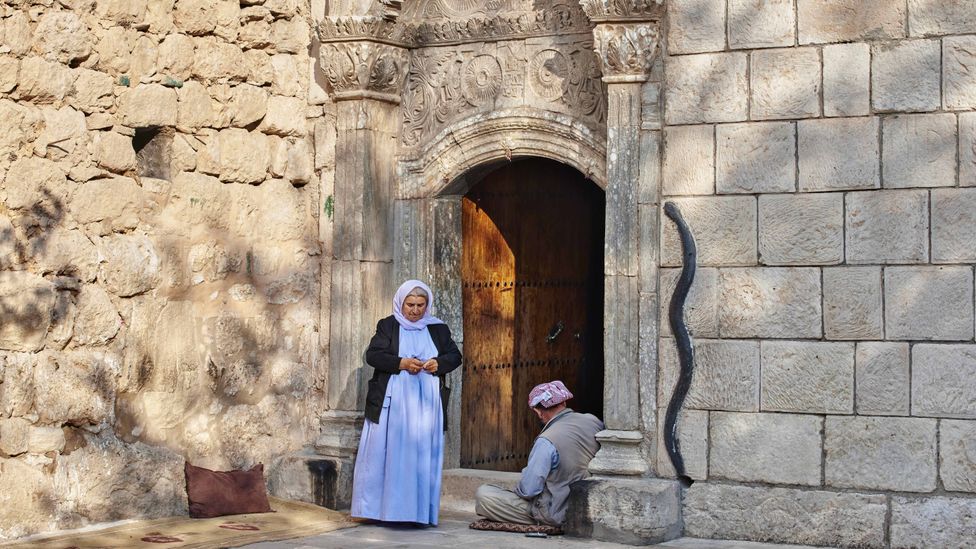Located 125km north-east of Erbil (the capital of Kurdistan, an autonomous region of northern Iraq), lies the hamlet-sized shrine complex of Lalish, the holiest site of Yazidism, an ancient religion with an estimated 700,000 followers worldwide.
“Lalish is as sacred to the Yazidis as Mecca is to Muslims or Jerusalem is to the followers of Islam, Christianity and Judaism,” said Luqman Mahmood, the director of visitor relations.
The 4,000-year-old site (which is also open to non-believers) consists of a number of shrines featuring distinctive fluted, conical spires, the most revered of which contains the tomb of Sheikh Adi ibn Musafir, considered the founder of the faith.
(Credit: Simon Urwin)
The exact origins of Yazidism are a matter of dispute, but it is thought to date back more than 7,000 years and, over time, has come to incorporate elements of other faiths, including Zoroastrianism, Sufi mysticism, Christianity and Judaism.
Yazidism’s principal beliefs are that there is one God (“Kuda” in Kurdish) who created humankind, while all other living beings were the work of seven angels led by the ruling Peacock Angel named Malak Taus.
“Another important facet of the Yazidi faith is the belief in our oneness with the natural world, which has its roots in ancient nature worship,” Mahmood told me. “The black snake on the temple doorway (pictured above) symbolises our respect for Mother Nature; we’d never kill a snake, even if it was venomous.”
The snake is particularly symbolic for Yazidis who believe that after Noah’s Ark sprang a leak when it came to rest on the peak of Mount Ararat, a serpent plugged the hole with its body and saved the ship from sinking and all those on board from drowning.

(Credit: Simon Urwin)
Like Muslims travelling to Mecca, Yazidis are obliged to make a pilgrimage to Lalish at least once in their lives; those who live in Kurdistan or Iraq should visit at least once a year. Pilgrims and visitors must enter the complex in modest attire and walk barefoot out of respect for the sanctity of the site.
Once inside, a popular Yazidi tradition is the tying of girêk (knots) in silk scarves hung around pillars and trees. The different colours represent the seven angels, while each knot represents a prayer. Yazidis believe that by untying the knot of a previous pilgrim, it will grant that person all their wishes.

(Credit: Simon Urwin)
Lalish is home to just 25 permanent residents. They include: a priest; various monks; a nun; and so-called “servants of the house”, who are responsible for cleaning, maintenance, caring for the surrounding forests of fig, walnut and olive trees and collecting soil for pilgrims.
It is said that every Yazidi should possess soil from Lalish and carry it with them like a talisman. Soil is also a key part of Yazidi funerary rites: it is mixed with holy spring water and small mud balls are placed in the mouth, ears and over the eyes after death. Coins are also placed in the coffin (an ancient Babylonian tradition) so that the deceased have money to spend in heaven.
Pictured above: a “servant of the house” burns lengths of white string in exchange for donations to cure the sick, bless the dead and bring good luck to the living.

(Credit: Simon Urwin)
Olives from Lalish’s forests are pressed barefoot in wooden barrels and the oil is stored in clay pots in one of the complex’s caves (pictured above.) The oil is a vital part of devotional practices. Yazidis pray facing the sun, at least twice a day, at both sunrise and sunset; as dusk approaches, 365 olive-oil lamps (one for each day of the year) are lit around the site to represent the light of the sun and the light of God. Light also plays an important role, even in death, since Yazidis are buried so as to face the rising sun.

(Credit: Simon Urwin)
The Yazidis’ unconventional beliefs have led to a long history of persecution. “It first began in the time of Osman I, founder of the Ottoman Empire,” said Mahmood. “We can count more than 70 different occasions of genocide since then, most recently by Saddam Hussein and members of Islamic State.”
Mahmood went on to tell me the jamadani headdress Yazidi men wear were once pure white, but those worn at Lalish are now chequered with red to represent Yazidi bloodshed. “Wearing traditional dress not only pays respect to those we have lost but is another way to keep our culture intact,” he added.

(Credit: Simon Urwin)
Friday is the Yazidi holy day when members of the community converge on Lalish in vast numbers to pray and socialise. “Food seals the bond of togetherness,” said Edee Mahmood, Luqman’s wife, who invited me to join the family for lunch.
In an open-air kitchen, she and other women prepared mutton-based dishes and shared them with family, friends and pilgrims from the Yazidi diaspora (pictured above). Despite the warm hospitality, Edee told me that the Yazidis do not think of themselves as an inclusive community since they do not accept conversion, nor intermarriage with other faiths. “If we keep Yazidism pure, we can maintain our way of life. That keeps our souls peaceful and means we are capable of enduring anything that comes our way. Without deep roots, the tree will soon fall. It is the same with Yazidism.”
BBC Travel’s In Pictures is a series that highlights stunning images from around the globe.
—
Join more than three million BBC Travel fans by liking us on Facebook, or follow us on Twitter and Instagram.
If you liked this story, sign up for the weekly bbc.com features newsletter called “The Essential List”. A handpicked selection of stories from BBC Future, Culture, Worklife and Travel, delivered to your inbox every Friday.
